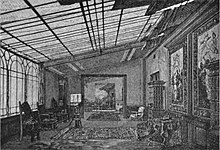Adèle (photo studio)
Adèle was the name of a photo studio in Vienna that was known for its portrait photos.
history
The studio was founded by Joseph Perlmutter for his children Adele, Wilhelm and Max in 1862. The family came from Galicia . Adele Perlmutter , who gave her name, was a court photographer from 1868 and received numerous awards. Henry Baden Pritchard visited the studio in 1882 and wrote in his book Studios of Europe that the Adèle studio was “second to none in the imperial city; While we may also remark that in some respects it is the finest studio we have ever visited. "
From 1862 the atelier had its first location in the newly opened Hôtel de l'Europe, Praterstraße 18 on the corner of what was then Untere Fischergasse (today Aspernbrückengasse), where it can be found at Asperngasse 2, changing building address in 1876 , until 1885. The second studio was in Graben 19 (1874–1838). There was also an open-air studio (1879–1884) in the former zoo in the Prater , where “Photograpie hippique” was operated, and branches at Wallfischgasse 9 (1886) and 11 (1887–1900) and in Ischl , the place of the imperial summer residence. Adele Perlmutter retired from the business around 1890. The photo studio continued under the name "Adèle". From around 1890 it was run by Wilhelm Perlmutter as the sole owner. In 1894 he changed his surname to "Förster"; his son Ernst, born on December 4, 1879, became a co-owner in 1908. Wilhelm Perlmutter or Förster died on February 14, 1918 at the age of 75.
After that, Ernst Förster was the only owner of the studio, which at times also operated as “Adèle-Förster”. In 1904 he took part in the exhibition of the Photographische Gesellschaft Wien in the Austrian Museum for Art and Industry , left the Jewish community in 1914 and emigrated to Czechoslovakia with his wife Helene in 1938, the year Austria was annexed to the German Empire . 1942, the pair was Prague in the as ghetto called transit camp Theresienstadt deported, prevailed in the appalling living conditions and lacked any medical care. According to the death report issued there, Ernst Förster died on July 26, 1943 in Block E IIIa of pneumonia and blood poisoning.
After Förster's emigration and during the Second World War, the negative holdings of Atelier Adèle remained in Graben 19 in Vienna, where the photo studio that had been abandoned in 1938 was located. In summer 1945, at the instigation of the Vienna Photographers' Guild, these negatives were to be handed over to the ÖNB ; apparently this handover did not take place after all.
Around 50 photos from the Adèle studio had already reached the National Library's picture archive in 1944. However, they were only processed around 1950 and inventoried by Hans Pauer in 1953 .
literature
- H. Baden Pritchard: The Atelier Adèle in Vienna , in: The Photographic Studios of Europe , London 1882, pp. 250–252 ( digitized version )
Web links
- Images from photographs
- Austrian National Library . (You must enter "Atelier Adèle" under "Your search term".)
Individual evidence
- ^ Secker & Warburg for the Leo Baeck Institute: Year Book . Secker & Warburg for the Leo Baeck Institute, 1987, p. 444 ( limited preview in Google book search)
- ↑ Timm Starl thinks that the choice of the studio name with the French spelling served to disguise the Jewish origin of the owners. See Timm Starl, women's job and hobby. Women photographers in Austria until the First World War , 2014, p. 4 ( digitized version )
- ↑ Pritchard, p. 250
- ↑ Adolph Lehmann's general housing advertiser together with trade and commercial address book for the imperial capital and residence city of Vienna and the surrounding area, 1885, Vienna , category photographers , p. 1359.
- ^ Adele Wien Hof-Atelier at www.klosterarchiv.ch
- ↑ Details on the history of the studio at www.zvab.com
- ↑ According to the obituary for Clara Perlmutter, geb. Margulics, in 1908 the four siblings Wilhelm Förster, Adele Heilpern, b. Perlmutter, who wrote her first name in this ad without an accent, Max Perlmutter and Anna Fraenkel. See www.anno.onb.ac.at
- ↑ Obituary notice for Wilhelm Perlmutter on www.anno.onb.ac.at
- ↑ Ernst Förster death report , issued in the Theresienstadt ghetto on July 26, 1943, on geni.com
- ^ Albertina Collections Online at sammlungenonline.albertina.at
- ↑ Murray G. Hall: ... to get hold of all kinds of things for the national library .... Böhlau Verlag Vienna, 2006, ISBN 978-3-205-77504-1 , p. 351 f. ( limited preview in Google Book search)

